October 5, 2007
Air Date: October 5, 2007
FULL SHOW
SEGMENTS
DDT and Breast Cancer
View the page for this story
Exposure to DDT at a young age may indicate a greater risk for developing breast cancer, according to new research by Dr. Barbara Cohn of the Public Health Institute in Berkeley, California. Dr. Cohn speaks with host Steve Curwood. (05:15)
Miner Safety Getting Shafted?
/ Jeff YoungView the page for this story
Investigations of the latest coal mining tragedy are raising troubling questions, not just about the company in question but also about the top government agency charged with mine safety. Critics say lax enforcement is linked to a spike in coal mining deaths. Living on Earth's Jeff Young reports. (06:30)
Green Collar Revolution
View the page for this story
Today’s green revolution must involve people of all economic levels. That’s according to Van Jones, co-founder of the Ella Baker Center for Human Rights in Oakland, California. Jones recently attended the Clinton Global Initiative conference where his “green for all” campaign - to promote green business training for people of color and low incomes - was featured. He talks with host Steve Curwood. (08:00)
Red Sox Green Team
View the page for this story
The Red Sox have a new five-year initiative to help Boston's beloved Fenway Park go green. With plans on the drawing board for solar panels, a new recycling program, and locally grown produce at the concession stand, the Sox are heating it up. Host Steve Curwood visits Fenway Park to see whether Boston's competitive edge on the field can hold its own in the environmental world. (06:00)
San Francisco Lights Out
View the page for this story
Nate Tyler wants his fellow San Franciscans to turn out the lights for an hour on October 20th to highlight the problem of high energy consumption and its contribution to global warming. Tyler talks with host Steve Curwood about his Lights Out San Francisco campaign. (03:30)
Longing for New Orleans
/ Ingrid LobetView the page for this story
Between thirty and forty percent of New Orleanians have not returned to the city since the levees failed in 2005. Some have found better lives elsewhere, but many yearn to come back. Living on Earth’s Ingrid Lobet has a portrait of one family’s struggle to return to their beloved city. (15:45)
This week's EarthEar selection
listen /
download
A Southern serenade of tree frogs.
Show Credits and Funders
Show Transcript
HOST: Steve Curwood
GUESTS: Dr. Barbara Cohn, Van Jones, Nate Tyler
REPORTER: Jeff Young, Ingrid Lobet
[THEME]
CURWOOD: From Public Radio International—this is Living on Earth.
[THEME]
CURWOOD: I’m Steve Curwood. The growing revolution in green energy systems to fight climate change is the perfect opportunity to generate jobs for the poor, say advocates. They’re calling for a massive ‘green-collared’ jobs program.
JONES: The next step for the environmental movement will be to embrace a social uplift environmentalism that says: ‘the way we solve our ecological problems will be to create wealth, health, and work opportunities for people who were left out of the pollution-based economy.
CURWOOD: Also, strong evidence links DDT and breast cancer for baby boomers. And the inside scoop on what’s green about the Boston Red Sox.
DEE: We want to be on the cutting edge within professional sports to take the lead on this very important environmental and social issue.
CURWOOD: We’ll have those stories and more this week on Living on Earth. Stick around!
[THEME]
ANNOUNCER: Support for Living on Earth comes from the National Science Foundation and Stonyfield Farm.
[THEME]
DDT and Breast Cancer
CURWOOD: From the Jennifer and Ted Stanley studios in Somerville, Massachusetts, this is Living on Earth. I’m Steve Curwood. For years the pesticide DDT has been a major suspect in the breast cancer epidemic. But studies looking at DDT residues in the tissue of women with breast cancer have been contradictory.
A new study published in Environmental Health Perspectives is based on actual blood samples preserved from as long as 40 years ago and the results are startling. It shows that if a female is exposed to DDT before puberty, she is five times as likely to get breast cancer as a woman who is exposed to DDT later in life. And virtually every female in the U.S. who was a child between 1945 and 1965, when DDT was widely used, is in a high-risk category. Dr. Barbara Cohn from the Public Health Institute in Berkeley, California was the lead author of the study. I asked her how she was able to get her data.
COHN: Well we had begun a very long-term, 40-year follow-up of a large group of women who had originally lived in Oakland, California. And as part of this study we had taken blood samples and archived those blood samples during the 1960s. And as you know, in the United States DDT wasn’t banned until 1972 and for that reason these archived blood samples were taken from women at a time when DDT was in very active use.
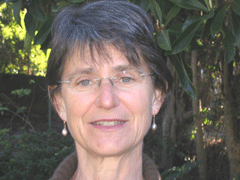
Dr. Barbara Cohn (Courtesy of Dr. Barbara Cohn)
COHN: The existing data that we have on animals suggest that some tissues in the body are much more sensitive to toxic exposures at a young age and even sometimes before birth. The other piece of evidence that is very important is regarding the only known strong environmental risk factor for breast cancer and that is radiation. And what we know about radiation comes to us from the very horrible experience of Hiroshima and Nagasaki; the atomic bomb blasts there. And what we learned from that work is that when women were young when exposed to radiation at the time of the blasts, they had an excess risk of breast cancer. But when women were not young at that time of the blast, the excess risk of breast cancer was small or not present. And so that’s the strongest evidence we have that the age that you are may determine whether the breast is vulnerable to a toxin or an insult that might cause breast cancer.
CURWOOD: Let’s say a girl is exposed to DDT at age six or seven. It’s not very likely she’d see the breast cancer develop until what—she’s in her fifties? Why does it take so long?
COHN: That’s an excellent question. From what we seem to know, especially again, from the atomic bomb blasts data, that when women did experience an excess risk of breast cancer after the bomb it was at the age when breast cancer is expected to develop—not at a particularly earlier time. And what we think is, is that the body has defenses against the development of abnormal growth, which is what cancer is, and that as we age those defenses are not as good and begin to break down. And for that reason, cancer is more common in older individuals.
CURWOOD: So, how were these girls exposed to DDT?
COHN: We can’t say for sure. We don’t have that information. But we do know that there was a very large use of DDT in the United States during this period, peaking around 1959, according to the EPA report on just the tonnage, and probably in the diet, peaking around 1965. The use was very broad for many, many different—agricultural, pests, and in gardens, and all around communities. So the levels that we measured in the blood of our women were actually quite high but they weren’t special individuals, they weren’t agricultural workers, they didn’t particularly have a history of living on the farm. They were just women who were living in the Oakland, California area in the 1960s.
CURWOOD: So DDT gets introduced for broad use in 1945, and looking at your study you estimate that the peak dietary exposure was in 1965. So that would mean today that these women are 62-42 years old. For women in this age group listening right now—what do you recommend that they do?
COHN: That’s the best question of all. There are some things that we can’t change: we can’t change our family history, and we can’t change the history of our DDT exposure, either. And so, there wouldn’t be much point in being tested for what was in your blood now because what is in your blood now probably wouldn’t tell us what you were exposed to when you were young. So the most practical advice that I can give is to try to control the characteristics or the risk factors that you can control. The newest data to come out is on alcohol use and there has been a recommendation that women who might be in a higher risk group—perhaps people with a family history—might want to review and consider how much alcohol that they drink. And our motivation in doing this work is to provide information to improve the health of the public and to hopefully be able, eventually, to treat, conquer, and prevent the health problems that so plague us.
CURWOOD: Dr. Barbara Cohn is center director of the Child Health and Development Studies at the Public Health Institute in Berkeley. Thank you so much.
COHN: You’re welcome.
Related links:
- Public Health Institute
- Child Health and Development Studies
- "Any Type of Alcohol Drink Raises Breast Cancer Risk, New Study"
[MUSIC: Rachel Z “Maps” from ‘Dept Of Good And Evil’ (Savoy Jazz—2007)]
Miner Safety Getting Shafted?
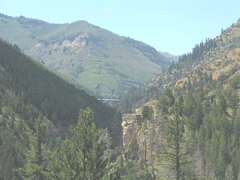
Crandall Canyon, UT (Courtesy of JP Shooter/Flickr)
CURWOOD: Six Utah coal miners and three people trying to rescue them were killed back in August, but in some respects the story is just beginning. The tragedy is sparking a call for a top-to-bottom review of mine safety and already congressional investigators are saying there are serious flaws in the procedures of both the mining companies and the federal agency that is supposed to keep mines safe. Living on Earth’s Jeff Young has the latest in our series, “Generating Controversy: the Changing Climate of Coal.”
YOUNG: Wendy Black remembers there was a meteor shower the last night of her husband’s life. They’d been having long talks at night because, for the first time in 24 years as a miner, Dale Black was scared of the mine.
BLACK: I have never known my husband to be afraid to go to work but the last part of his life he was. While we were getting ready to go to bed he said that they’d been having big enough bounces at the mine that they were registering on the Richter scale. This was the night before the initial collapse.
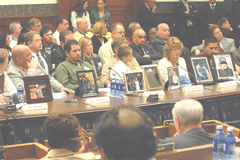
Wanda Black (far right) and other family members of miners who died at the Crandall Canyon mine tragedy appeared before the House Education and Labor Committee October 3rd. (Courtesy U.S. House of Representatives)
BLACK: Like: ‘who was in charge at the time of the rescue? Who approved of this mining plan and who was to oversee this plan and that it was being followed correctly?’

Crandall Canyon, UT (Courtesy of JP Shooter/Flickr)
MURRAY: Albert Gore is a shaman of global goofiness and we’d better not be listening to him.
YOUNG: Murray Energy Corp. operates mines in five states, making it the country’s 12th-largest coal producer. But campaign finance records show Murray energy is the industry’s third-biggest political donor. Notes from a 2002 meeting with mine safety inspectors show he is not shy about mentioning those political connections. The notes quote him threatening to have mine inspectors fired, and bragging about his connections to Kentucky Republican Senator Mitch McConnell. McConnell’s wife, Elaine Chao is Secretary of Labor, the department that contains the mine safety agency. According to the notes, Murray said: ‘McConnell calls me one of the finest men in America and last I checked he was sleeping with your boss.’ This August, as the rescue effort dragged on at his Crandall Canyon mine, Murray was a frequent media presence.
MURRAY: This is the first major accident I’ve ever had in one of my coal mines! In 20 years! And this was caused by an earthquake! It was a natural disaster: an earthquake.
YOUNG: Safety records show two miners have died in other Murray mines in the past ten years. The Crandall Canyon miners were using a practice known as pillar removal and retreat mining. It’s a common but hazardous practice, especially so in deep mines like the one in Utah, because geologic pressures are so great. Safety experts who viewed the mining plan after the accident say it was seriously flawed.
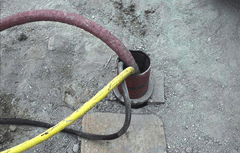
A bore hole, after the mining accident in Crandall Canyon, UT (Courtesy of Pruned/Flickr)
FERRITER: And I looked at it and I said, ‘my lord, what are these people doing?’
YOUNG: That’s Bob Ferriter, who directs the safety program at the Colorado school of mines. He previously worked for the Mine Safety and Health Administration, known as ‘MSHA’ for short. A computer analysis done after the accident confirmed what Ferriter saw in the plan: great stress on the remaining pillars. And Ferriter says safety concerns forced the mine’s previous owners to shut down a section. He says those should have been red flags for the safety agency.
FERRITER: And MSHA said, ‘oh yeah, that’s okay,’ which totally surprises me. Somebody is going to have to look deeply inside of MSHA and find out what is going on.
YOUNG: Some members of Congress promise to do just that. They’re disturbed by the recent spike in mining deaths_71 in less than two years. West Virginia Democratic Senator Robert Byrd says Congress approved extra money specifically for MSHA to hire more inspectors. But since July two miners died in mines that had not been inspected as law requires. The agency said it was too short of staff.
BYRD: It is infuriating to watch MSHA continue a tepid, disjointed approach to mine safety. What the hell does it take to shake up that agency? What the hell is the problem at MSHA? It’s no secret . . .
[APPLAUSE]
YOUNG: Pennsylvania Republican Senator Arlen Specter says MSHA has shifted away from strict enforcement in favor of something called ‘compliance assistance.’
SPECTER: So we’re really looking at a situation as to whether we have a license to ignore the law.
YOUNG: Mine Safety and Health Director Richard Stickler defended the agency’s enforcement record. He’s ordered a review of roof control plans for other deep mines doing pillar removal mining. And as for questions about the approval of the Crandall Canyon mine plan:
STICKLER: Our accident investigation team will go through a full analysis of the computer models and the review process and in due course they will answer that question.
YOUNG: Stickler says Labor Secretary Chao has also appointed an independent panel to investigate MSHA’s actions. But critics point out that the ‘independent panel’ consists of two of the agencies former employees. Wanda Black says it does not sound like the way to get answers about why her husband died.
BLACK: Now explain something to me: how do you truthfully investigate yourself? MSHA has one job: mine safety and health administration. It would have taken just one MSHA official doing his job to have saved my husband’s life. Please at least have one person with enough backbone to say, ‘no more.’
YOUNG: For Living on Earth, I’m Jeff Young in Washington.
Related links:
- Click here to read the notes from a meeting between MSHA inspectors and Bob Murray.
- U.S. Dept. of Labor: Mine Safety and Health Administration's page on fatalities
- U.S. Rep. George Miller's (D-CA) Committee on Education and Labor
[MUSIC: Beastie Boys “The Rat” from ‘The Mix Up’ (Capitol Records—2007)]
CURWOOD: Coming up, a new contest in the ballparks of major league baseball. Stay tuned to Living on Earth.
Green Collar Revolution

CURWOOD: It’s Living on Earth. I’m Steve Curwood. Every year former President Bill Clinton invites more than a thousand movers and shakers to his Global Initiative. And this year, once again, much of the focus was on clean water and climate change. Among those in the crowd: Brad Pitt, Angelina Jolie, Alicia Keys, former Vice President Al Gore, and Van Jones.
Van Jones is the cofounder of the Ella Baker Center for Human Rights in Oakland, California and has become perhaps the leading proponent of a movement to link the fight against poverty to the fight against global warming. Van Jones calls his plan ‘Green for All’ and he joins me now on the line from California. Hi Van, how are you?
JONES: How are you?
CURWOOD: Good, so tell me about Green for All.
JONES: Well, a lot of people are very excited about the transition to a cleaner, greener strategy for the U.S. But what people haven’t figured out is—there aren’t going to be any magical green fairies to go around and put up all these solar panels or build all these wind farms. There are going to have to be U.S. workers and right now we do not have a national strategy to train the millions of people who are going to be needed to work in a green, clean economy.
For instance in northern California there’s already a labor shortage for putting up solar panels. People want them, the technology’s there, the capital is there, and they don’t have the trained workers. So we say, ‘well, hold on a minute.’ We’ve got all these people in low-income communities who need jobs and now we’ve got all these new green-collared jobs that are opening up. And we came up with a plan and we called it ‘Green for All.’ It’s a billion dollars from the federal government over a four-year period to infuse all of our community colleges, public schools, vocational schools, with the dollars to be able to start training people to meet this coming labor demand.
CURWOOD: So, let’s say for a kid who’s growing up in a tough neighborhood, say right there in Oakland, you know, surrounded by some polluting industry. How does installing solar panels sound as a career path?

Van Jones (Photo: The Ella Baker Center for Human Rights)
JONES: Well, you know, it’s amazing. Most people would assume that it’s something that you would have to really convince someone to want to do or that it would be so outside their frame of reference. But, you know, these young people are really smart. And it only takes about, you know, 90 seconds, to say: ‘a billion dollars are moving into a new industry, they don’t have enough workers, if you get in now, do a good job, you can move up relatively quickly and you could be making anywhere from $21-$30-$35 an hour.’ People say, ‘Hey—sign me up.’ It’s not a hard sell.
There’s a wonderful program, which I just can’t stop bragging on, called ‘Solar Richment,’ where they got a modest amount of money, got 20 guys—you know low-income African American, Latino, Phillipino, one African-American woman. For nine weeks these guys got up, this young woman got up, every morning. They had to be there at nine o’clock. They had to learn these skills. Nine weeks later they did their first installation. There were local TV cameras there, solar employers were there saying, ‘hey, we need workers.’ And you know, the look on these young people’s faces. Often these are the young men who are always seen as the villains and yet here they are, nine weeks later, African American, Latino, with the baggy pants, the hair or whatever, but they’ve got their work boots on, they’ve got their orange jerseys on, and they’re doing this work. And they are the ecological heroes.
This is the new base of the environmental movement. The next step for the environmental movement will be to embrace a social uplift environmentalism that says: ‘the way we solve our ecological problems will be to create wealth, health, and work opportunities for people who were left out of the pollution based economy.’ We’re going to lock them into this new clean and green economy and in that way we can save the polar bears and you know, these poor kids, too.
CURWOOD: Where are they going to be doing this work? Are they going to be driving out of Oakland into Marin County to these multimillion-dollar homes to do this work, or well—where will they be working?
JONES: Well I tell you what, right now the way that the renewable energy is structured, that would be all that they’re able to do. But what you have to realize is that as we move forward, one percent of the world’s land mass is cities—and that’s where 80 percent of the global warming pollution is coming from - so the huge retrofit job that we need is an urban agenda. So the thing about it is, that we’ve got to make it possible for low-income people to fold solar into their mortgage payments, so they pay just a little bit more every month on their mortgage but those solar panels go up right away. We’ve got to come up with creative financing so that the people who most need to get their energy bills cut have the access to that technology. And their cousins, their nieces, their nephews, their children are getting trained to actually implement that technology. That’s when you actually begin to see the emergence of a fundamentally new economy.
The first industrial revolution hurt the people and the planet, too. The second industrial revolution—carbon constrained, much smarter on resources, much smarter on water, energy—the next industrial revolution has to help the people and the planet. And in order to do that, you’ve got to put people to work. And not just as workers but on their way to managers, owners, investors, inventors. You’ve got to bring people who were left out of that pollution-based economy into the heart of the green economy.
CURWOOD: Van, looking back at your experience at the Clinton Global Initiative, there were a lot of great ideas being floated there: everything from reforestation of the Brazilian Amazon to water sanitation in India, green education for Chinese mayors, and of course your notion of Green for All. What was it like being there to witness this—well, maybe we should call it a philanthropic juggernaut—in action?
JONES: (laughs) Well, you know, it was really overwhelming, I mean you’re there, and you know how it is at these conferences, you go and sit down at a panel, or not a panel but you know, a workshop and you look up. And there’s Brad Pitt, you know, making a speech about how we need to green New Orleans and green the Ninth Ward and how he’s putting millions of dollars of his own money into it. And you’re like, is this a fantasy? I mean, what is this? And you turn around and there’s Bill Clinton, you know, marching with these energy CEOs and you’re thinking, ‘oh God, these are the people I’ve been fighting my whole life.’ And they’re up there waxing eloquent and getting weepy about how they’re going to cut all this carbon out of the economy and they’ve got the power to do it.
So it’s an interesting moment because the politics of climate change have moved from the margin of science and the margin of politics to the very center. And I think those of us who have been fighting for environmental and social justice for a long time, it’s easy to get “oh wow, we’ve made it, it’s super exciting, we get invited to these things now.” I think we’ve got to say very clearly, “Any movement that goes from the margin to the center has to answer a moral question and that’s this: who will we take with us and who will we leave behind?’ And it will be very easy at this point, for the eco-elite, and I put myself in that, to say “Hey, you know, we’ve made it, you know, Bill Clinton and all these people love us.” But you still have the majority of people in America who have not been included in this environmental revolution and the next step has to be to include them, too.
CURWOOD: Van Jones is a lawyer and cofounder of the Ella Baker Center for Human Rights in Oakland. Thank you so much, Van.
JONES: Well I’m happy to get a chance to be on the show again and thank you for your interest.
Related links:
- Green for All
- Ella Baker Center for Human Rights
[MUSIC: Jonathon Richmond “Vacant Lot” from ‘Summer Revolution’]
Red Sox Green Team

(Photo: Steve Curwood)
CURWOOD: It may be just about the end of the baseball season, but the other day we got a tip to head over to Fenway Park, the home of our hometown team, the Boston Red Sox. On tap: the opening day of a five-year plan to make Fenway Park more environmentally friendly, starting with something brand new for the BoSox: recycling.
[JAUNTY MUSIC FROM YAWKEY WAY]
CURWOOD: The Red Sox crowd likes to show up early to chow down and drink up, especially hot dogs and beer—make that lots of beer. And when more than 30,000 people party and watch a game under the lights, it takes a lot of electricity. And they create mounds of cans and bottles and cups that could probably cover an entire infield. So how do red-blooded Red Sox fans feel about this being first night for recycling bins at the game?
WOMAN: I think it's great idea. I'm surprised they don't already recycle.
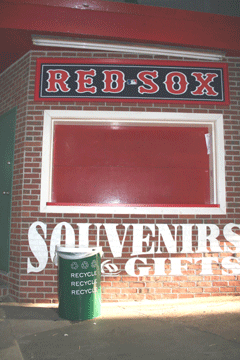
One of forty new recycling bins placed throughout Fenway Park. (Photo: Emily Taylor)
MAN: I think it's a great idea. It’s a good example the Red Sox are showing.
[SOUND OF BAT HITTING BALL, CROWDS]
KIRSCHNER: With this home stand actually tonight we’re starting our recycling program, minimal as compared to how it will be on opening day 2008—it’ll be full scale across the ballpark.
CURWOOD: That’s Katie Kirshcner, the Senior Manager of Business Operations for the Red Sox
KIRSCHNER: We have 40 recycling bins scattered throughout the ballpark telling fans they can recycle their soda and water and bottles in these cans. Next year on 2008 we hope to do our beer cups that we produce quite a few of here at Fenway. We’re taking baby steps now with our recycling program starting tonight and then we’re also—our big off- season project that we are in the process of considering and working on—is solar panels on the roof.
CURWOOD: Recycling. Solar panels. What is it that has suddenly inspired the Red Sox to go as green as their famous short left-field wall known as the Green Monster? Hey, this is sports. So think competition. And while the American League's Red Sox and Cleveland Indians may have tied this year for the best win-loss record in baseball, it turns out that the Indians beat out the Sox on going green by already putting in more than 8,000 watts of solar panels at Jacobs Field.
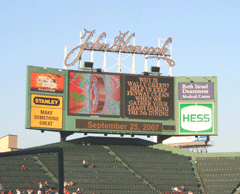
"Why is Wally green? Help us keep Fenway clean when we gather your trash during the 5th inning."(Photo: Steve Curwood)
DEE: This is something we believe in a great deal. We want to be on the cutting edge within professional sports to take the lead on this very important environmental and social issue and we think there's a great opportunity, not only to set the standard for sport facilities, but the standard for the country in taking this under our wing.
CURWOOD: And does Mike Dee think the Red Sox will be carbon neutral in five years?
DEE: (laughs) That's our goal. Nah, I shouldn't say that. We are going to certainly use this—we hope—as a springboard to do other things in the ballpark. We are privileged to have the country's oldest, most-beloved ballpark. In 2012 we are going to be celebrating—for the first time every—the 100th birthday of a sports facility that is still functional—professional sports facility—that is still functional here at Fenway. So wouldn't it be great if that 100 year-old facility led the league in environmental practices and setting the standard for newer facilities to follow.
CURWOOD: For years Fenway Park has mulched their grass clippings to cut down on fertilizer and minimize the use of pesticides. But this new major league effort to go green has been inspired for the most part by the Natural Resources Defense Council in partnership with Major League Baseball, the umbrella organization for pro ball. And beyond recycle bins and solar cells, the NRDC effort encourages clubs to think local when it comes to all that food and drink for the crowd.
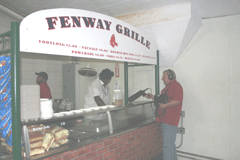
Living on Earth's Jeff Turton lets the hot dogs do the talking. (Photo: Emily Taylor)
HAGGERTY: We ah, extensively shop the local markets for local seafood, produce, bread.
CURWOOD: Kevin Haggerty runs the Fenway food concession for the Aramark Company.
HAGGERTY: We use local hot dogs. Some are made over in Chelsea. But through the summer we had our chefs—in the Premium areas, in the suites—have a very concentrated effort on using local and organic farmers.
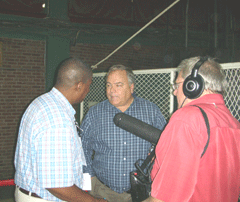
ARAMARK director Kevin Haggerty talks to Steve on the concourse. (Photo: Emily Taylor)
WOMAN: Anything with healthy food is fine with me.
MAN: I agree with her.
MAN: Well, I think it's very good. Anything that helps to promote a better environment is good for everybody in the area. If everybody does that then maybe it makes a difference to the environment.
[SOUND OF CROWDS AND BATS HITTING BALLS]
CURWOOD: And Red Sox Senior Business manager Katie Kirschner was hoping for just that reaction.
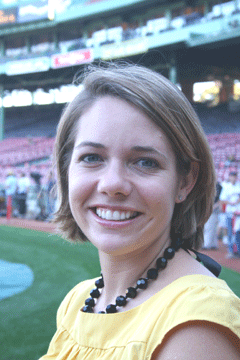
Katie Kirschner (Photo: Emily Taylor)
CURWOOD: So for now, the race is on for the Boston Red Sox. And maybe it's no accident that the competition is fierce for what one might call the "green pennant." Of the four greenest teams in baseball, three of them made it to the playoffs this year, and the fourth is home to the home run king.
[CHEERING FANS; SPORTSCASTER SHOUTING “ . . . THREE NOTHING RED SOX!”]
Related links:
- The Boston Red Sox
- Natural Resources Defense Council
[MUSIC: The Standells “Dirty Water” from “The Live Ones” (Sundazed Music—2001)]
San Francisco Lights Out

The San Francisco skyline will be dark for one hour on October 20. (Courtesy of NASA)
CURWOOD: A while back Nate Tyler was in Sydney, Australia when the lights went out. This hour of darkness was actually planned by environmental advocates to call attention to the problem of high-energy consumption and carbon dioxide emissions. The down under Earth Hour inspired Nate to launch his own campaign for an hour of darkness in his hometown of San Francisco. So, Lights Out San Francisco will take place on October 20th. And the motto: “Good things happen in the dark.”
TYLER: So we’re going to distribute lots of free compact fluorescent light bulbs throughout the city, we are going to encourage people to turn off their lights for an hour between eight and nine that night. We’re working with local restaurants here to throw candlelight dinners throughout the city and we’re going to host a celebration, sort of a candlelight celebration in Dolores Park.
CURWOOD: Who’s responding to this? When you get hits on your website and all that, who says they’re in and ‘this is really cool?’
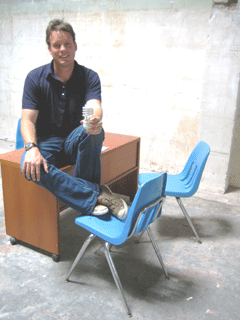
Nate Tyler is founder of Lights Out San Francisco.(Courtesy Nate Tyler)
CURWOOD: So, this seems to be an exciting project that’s taking off.
TYLER: It is taking off. So since launching Lights Out San Francisco our plan was always to make San Francisco a template that we could use in cities throughout the country. So, in conjunction with the folks in Sidney we are launching LightsOutAmerica.org, which is essentially targeting 15 cities throughout the country to turn off their lights on March 29th of next year.
CURWOOD: So how much electricity do you think you can save as a result of this one hour of darkness in downtown San Francisco?

The San Francisco skyline will be dark for one hour on October 20.(Courtesy of NASA)
CURWOOD: San Francisco’s a little smaller than Sidney, though.
TYLER: Yeah, it’s a smaller city but we’re also handing out 100,000 compact fluorescent light bulbs and there is an ongoing benefit there.
CURWOOD: What do you think will happen that will change people’s minds during this Lights Out San Francisco?
TYLER: I think it’s a great opportunity for people to pause for a moment and think about energy consumption and then to hopefully have some fun. I mean, I grew up on the East Coast and often times in the winter there were snow days and on those days when we didn’t go to school it was always a great opportunity for everybody to come out of their houses and shovel their front walk and shovel the front walk of their neighbors. I think it’d be fun for folks to turn off their lights and maybe sit on their front stoop and look up into the sky, and hopefully if all the lights go out they can see more stars that night.
CURWOOD: No unintended consequences? I remember the great blackouts here on the East Coast. You know, nine months later there seemed to be a lot of babies that came along.
TYLER: (laughs) Yeah, I mean, yeah. Good things do happen in the dark, for sure.
CURWOOD: Nate Tyler is founder of Lights Out San Francisco. For more information about the Lights Out America campaign, visit our website: www.loe.org.
Related links:
- Lights Out San Francisco: October 20, 2007
- Lights Out America: March 29, 2008
[MUSIC: Jimmy Witherspoon “When The Lights Go Out” from ‘Jazz Me Blues: The Best Of Jimmy Witherspoon- (Fantasy—1998)]
CURWOOD: Just ahead: when you can’t go home again—or at least not yet. New Orleanians long to return. Keep listening to Living on Earth.
ANNOUNCER: Support for the environmental health desk at Living on Earth comes from the Cedar Tree Foundation. Support also comes from the Richard and Rhoda Goldman Fund for coverage of population and the environment. This is Living on Earth on PRI. Public Radio International.
Longing for New Orleans

Houses like these blight Rev. Dejean's Gert Town neighborhood (Photo: Ingrid Lobet)
CURWOOD: It’s Living on Earth. I’m Steve Curwood. When you talk with some folks from New Orleans, whether recently returned or living far away, you can’t help but be struck by a deep current of pain just below the surface. Two years after the floods caused by the failed levees, the webs of human relationships that bring life joy, or make a neighborhood a neighborhood, are still in shreds. There are those Katrina exiles who have found better circumstances elsewhere and settled down. But many city natives say they want badly to return, but can’t. As part of our continuing coverage of the aftermath of the Gulf Coast disaster, Living on Earth’s Ingrid Lobet gathered these impressions.
LOBET: Pam Landrum emanates energy, despite some trying times. She was raised on the adage: ‘Fault finders are not fault correctors,’ so even all these years later, her conversation contains more praise than protest. And one person she can’t praise enough is Houston mayor Bill White.
LANDRUM: I’m telling you, I kept up, and I watched the compassion in this man. If I ever have a chance to meet him, I’m going to tell him ‘thank you.’
LOBET: Landrum, with two little grandchildren by the hand, spent three days in the New Orleans Superdome without food or a bath before a bus arrived and Mayor White welcomed them across the Texas state line.
LANDRUM: He’s going to go down in history for the care that he had for the people. He opened his doors and said, ‘bring those buses, 300 of them, to us.’ That is ama—what a great heart, for a person to have that: ‘I’m going to take care, I’m going to take you in distress.’
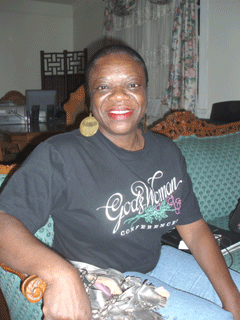
Pam Landrum (Photo: Ingrid Lobet)
LANDRUM: I took my money and I went to school. Sometimes I’d stay at school ‘til ten o’clock at night. I just had to get my purpose; I had to go back to what my purpose was.
LOBET: In the evenings after class, there was a sea of need. There was Pam’s daughter with two young children, and an elderly aunt, all of whom had also landed, like so many raindrops, in Houston. Then at the end of each week on Friday, Pam drove the six hours back to New Orleans where her mom had now returned after the storm, but was alone. And where new drywall, new fans and new speakers, had brought the sweetness back into Sunday at Ebenezer Missionary Baptist Church.
[EBENEZER MISSIONARY BAPTIST CHURCH SINGING, “VICTORY IS MINE”]
LOBET: But those brief weekend visits in New Orleans, for Pam’s mother, Reverend Lois Dejean, were no substitute for having her daughter and the rest of her family around her every day, as she’d been accustomed.
DEJEAN: If something should happen to me, who do I call? When your family is usually here to take care of you, but it’s not. I remember I had to go to the doctor to get a procedure done on me a couple of weeks ago, and my daughter was in Houston, and my granddaughter was in Houston, so I had to call one of the other young ladies in my church. And that was fine, but it would have been better if I’d had my children. I’m 71 years old—don’t you think I want my children around me? Just knowing they are around is comforting.
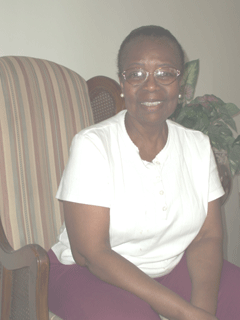
Reverend Lois Dejean is Associate Pastor at Ebenezer Baptist Church, directs the Gert Town Revival Initiative, organizes the annual "Rejoicin in the Park" Gospel festival and leads a youth choir. (Photo: Ingrid Lobet)
DEJEAN: We went to bed at six o’clock in the evening, (snorts, laughing) and the only place you can go every day is to Wal-Mart (laughs). So that’s where I went everyday was to Wal-Mart. That was seven miles from the house so you went seven miles to Wal-Mart and you come back home. You look at television. It was just killing me because I’m not a person to just sit down and look at television all day long.
LOBET: So as soon as she could find a place to rent—she’s never owned a home- Reverend D came back. But now, her gospel students were scattered. Her neighborhood, Gert Town, was wrecked. And so, rather than returning to the joy of her youth choir, she waded into the proverbial muck to rebuild her neighborhood.
[DOOR OPENING]
DEJEAN: Let me show you part of it
LOBET: Reverend D sits down at her computer and opens a PowerPoint file with photos of every property—distressed, destroyed, or repaired—in her neighborhood.
DEJEAN: We took a picture of every house, every empty space. Every thing in Gert Town, we took a picture of it.

Houses like these blight Rev. Dejean's Gert Town neighborhood (Photo: Ingrid Lobet)
DEJEAN: Oh let me tell you something, those students who did this, I love them.
LOBET: The students are helping Reverend D rebuild a neighborhood anchor—Miss Gloria’s, the dollar breakfast place on the corner. And with her damaged community now digitized, she says it’s easier to work through the city bureaucracy.
DEJEAN: I have such great passion for where I stay. It is my dream to see Gert Town become a viable community.
LOBET: But what’s true for Reverend D is true for many older people in the city these days. This wasn’t how she planned to spend these years, far from family, fielding calls from other elders in need, even testifying before Congress. And she’s exhausted.
DEJAN: I’m just tired. I’m extremely tired. I deserve the right to grow old, to finish growing old with things I want to do, not things that I got to do, like I got to get on it, I got to be, I got to—no.
LOBET: Knowing her mom is tired was stressful for her daughter Pam, in Houston, too. The family was still adjusting to going, overnight, from one that had lived close, for generations, to one that was sprinkled from Dallas to Nashville.
LANDRUM: It was very distressful for all of us to be broken up. It feels like a person died. That’s what it feels like. It feels like you miss something. That’s the best way I can describe it is—like a death.
LOBET: A death that’s a collective experience, somehow.
LANDRUM: When there’s a death and it’s localized in your house, then you have friends and you have other things you try to pull from. When everybody is experiencing the same thing—where are you getting your strength from? You know, because you want to tell the other person, ‘I need help right here, you know, I need my friend.’ But you know they are going through maybe not the same thing but they’re going through something like that. And the other thing that we experience so much is physical death, a lot of people are dying from stress, stress-related, so when you want to share, you think twice because you say—what are they going through? So it becomes harder to do that and harder to keep your network together.
LOBET: Pam says among the people she knows, there’s no bigger topic than how to get back to the city.
LANDRUM: I’m telling you, it’s huge. Because there’s no other place like New Orleans and most people feel comfortable in New Orleans. Because we have—our food is different, there are ways we communicate. Communication, believe it or not, we came home to vote and everybody was out at the voting poll saying ‘Hey!! How you doin?’ We don’t know each other! You’re just accustomed to speaking, ‘hi!’ I mean even if you pass someone—this is our custom—if you pass somebody you don’t know: ‘How you doin?’ or ‘Good morning!’ You get in an elevator full of people: ‘Good morning.’ I mean you were taught that—I mean, your mom chastised you if you went somewhere and there was a group of people there and you didn’t speak. But in other places you speak and people want to know—‘what’s your problem?’ or ‘what do you want?’ And so people want to come home for those different reasons, so they can relax.
LOBET: The cultural repercussions of such deep dislocation may be deep as well. New Orleans is known as a place that gave birth to jazz. The city also has a strong gospel tradition. Many local musicians come up through the church and are first schooled in gospel. And Pam’s family is a perfect example of that New Orleans musicality: nearly everyone plays music. The family has a gospel group that performs at Jazzfest. Her mother teaches gospel. And her brother Eddie is a drummer who’s experimented with gospel, funk, boogie woogie. In other words, the kind of innovation the city is known for.
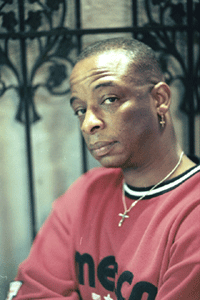
Eddie Dejean (Courtesy Eddie Dejean)
LOBET: With so many churches now empty, and families like the Dejeans consumed with economic survival, some have wondered whether the gospel circle will remain unbroken.
Music historian Lynn Abbot, in notes written after the storm, asks: ‘Will the little community churches that provide the necessary context for a viable gospel tradition in New Orleans manage to overcome the wandering in the wilderness, that has yet to subside? Will the likes of the Zion Harmonizers, the Spiritualettes, the Bemiss Brothers, the Melody Clouds, the Mighty Chariots, be able to maintain continuity? The fragile nature of our cultural heritage has been laid bare for all to see. Keeping it together is going to require a full measure of prayer and social commitment.’
Pam Landrum says for her, it was prayer, finally, that yielded results, when she was finally able to find a truck to borrow long enough to move her belongings back from Houston to New Orleans.
[SOUND OF PAGES TURNING AND LANDRUM TALKING]
LOBET: She kept track of all the agencies where she was turned down for a truck or the money to rent one—on three densely written 8.5 x 11 notebook pages.
LANDRUM: Oooh, there’s Houston, the Red Cross of Houston, Ooooh, Lord have mercy, I mean, Louisiana rebuilding, the Business Incentives, the S-C-I-C, I got all kind of stuff, City of New Orleans. Three months, three months.
LOBET: Pam usually has a smooth singer’s voice. But the move has her tired and her voice is strained. What she worries about now, besides finding a job, is her daughter and her aunt, still in Houston, and without much support.
LANDRUM: My aunt is in her seventies—that’s my mother’s oldest sister. She was crying every day, every day since Katrina, to come home. This is the only place she knew. This is a woman in her 70s. She cried so one day I mean I had a headache the whole day because it upset me so.
SHORT: People want to come home. People want to come home and the people who are not here, it’s not because they don’t want to be, it’s because they haven’t been given the opportunity to come back.
LOBET: Sabrina Short works with an interfaith group called All Congregations Together that helps religious communities mobilize. She says the Dejean-Landrum family’s experience is hardly unique. One thing she sees, even people with strong mutual support networks, is that they’re struggling to get their housing situation settled.
SHORT: It constantly came up that people are unable to rebuild: ‘I can’t rebuild because I don’t have money, I can’t rebuild because I am paying a mortgage on a house that doesn’t exist. I can’t even do anything with my home because my insurance is in jeopardy of getting cancelled.’ So there’s so many problems regarding rebuilding. And of course we are resilient. We’re going to try to rebuild with or without government help. We’ve done it before; we’ll do it again. But there are so many people, like our elders, who just don’t have the energy. We have low-income families who just don’t have the ability to take out a reconstruction loan and rebuild their house with $150,000.
LOBET: New Orleans, before the flooding of 2005, was a city where nearly 60 percent of people rented. Rents across the city have doubled and even tripled since Katrina. That’s a major barrier for many former residents. And yet Sabrina Short says when her church umbrella group began contacting people of the least means, people who had lived in public housing projects before Katrina, she was surprised by what she heard.
SHORT: What we found they were still in contact with each other, they still had each other’s numbers, they still called each other, and they were all over the country. Our people need help and it’s not people who are taking advantage of the system, it’s not people who are stealing from the government, or manipulating the system. It’s people who have a right to return.
LOBET: The right to return. You hear people here talk about it. It’s a right recognized by the United Nations, but not the United States. ‘Competent authorities,’ say the UN guidelines on internally displaced people, ‘have the primary duty to establish conditions, and provide the means, which allow internally displaced persons to return, in safety and with dignity, to their homes or places of habitual residence.’
Pam Dashiell is a community leader in Holy Cross, an African-American neighborhood that had high home ownership before the flood. She is blunt about the fact that New Orleans has lost many of its black people.
DASHEILL: To me that’s the crux of it all. I mean, there has been no organized effort to reach out and find us, to find the people who were dispersed. These are citizens of the United States. There should be an organized effort to recruit people back, to find us, and to get us back home.
LOBET: It’s common for people to trace their families’ roots here back to before the Louisiana Purchase, to plantation times, to slave times. Let that count for something, they ask now.
For Living On Earth, I’m Ingrid Lobet in New Orleans
[EBENEZER MISSIONARY BAPTIST CHURCH CHOIR SINGING “AMAZING GRACE”]
Related links:
- Sound of New Orleans: Artist Booking Service
- Eddie DeJean's website
- All Congregations Together: Music Rising
- Help Holy Cross: Holy Cross Neighborhood, New Orleans
CURWOOD: Next time on Living on Earth: He’s best known for his nature documentaries and has been knighted by the Queen of England. Now, Sir David Attenborough looks at what the eye of the artist can tell us about our perceptions of nature.
ATTENBOROUGH: I was invited to help in selecting the pictures and selecting the artists, which was of course an extraordinary privilege. I mean to rifle through drawings by Leonardo De Vinci (laughs) is quite a privilege.
CURWOOD: Sir David Attenborough’s “Amazing Rare Things,” next week on Living on Earth.
[SOUNDS OF FROGS RIBBITING]
CURWOOD: We leave you this week with a ‘ribbiting’ chorus.
[MUSIC: Lang Elliot & Ted Mack “Treefrog Serenade” from ‘Voices Of The Swamp’ (Nature Sound Studio—1996)]
CURWOOD: Lang Elliot and Ted Mack captured this tree frog serenade in Apalachicola, Florida for their “Voices of the Swamp” CD.
[VARIED, SIMULTANEOUS RIBBITTING]
CURWOOD: Living on Earth is produced by the World Media Foundation. Our crew includes Ashley Ahearn, Eileen Bolinsky, Bruce Gellerman, Ingrid Lobet, Emily Taylor, and Jeff Young—with help from Bobby Bascomb and Kelley Cronin. Our interns are Alexandra Gutierrez and Mitra Taj. Jeff Turton is our technical director. Alison Lirish Dean composed our themes. You can find us anytime at L-O-E-dot-O-R-G. I’m Steve Curwood. Thanks for listening.
ANNOUNCER: Funding for Living on Earth comes from the National Science Foundation; supporting coverage of emerging science, and Stonyfield Farm; organic yogurt and smoothies. Stonyfield pays its farmers not to use artificial growth hormones on their cows. Details at Stonyfield.com. Support also comes from you our listeners, the Ford Foundation, and Pax World Mutual Funds; socially and environmentally sustainable investing. Pax World: for tomorrow. On the Web at PaxWorld.com.
ANNOUNCER 2: PRI. Public Radio International.
Living on Earth wants to hear from you!
Living on Earth
62 Calef Highway, Suite 212
Lee, NH 03861
Telephone: 617-287-4121
E-mail: comments@loe.org
Newsletter [Click here]
Donate to Living on Earth!
Living on Earth is an independent media program and relies entirely on contributions from listeners and institutions supporting public service. Please donate now to preserve an independent environmental voice.
NewsletterLiving on Earth offers a weekly delivery of the show's rundown to your mailbox. Sign up for our newsletter today!
 Sailors For The Sea: Be the change you want to sea.
Sailors For The Sea: Be the change you want to sea.
 The Grantham Foundation for the Protection of the Environment: Committed to protecting and improving the health of the global environment.
The Grantham Foundation for the Protection of the Environment: Committed to protecting and improving the health of the global environment.
 Contribute to Living on Earth and receive, as our gift to you, an archival print of one of Mark Seth Lender's extraordinary wildlife photographs. Follow the link to see Mark's current collection of photographs.
Contribute to Living on Earth and receive, as our gift to you, an archival print of one of Mark Seth Lender's extraordinary wildlife photographs. Follow the link to see Mark's current collection of photographs.
 Buy a signed copy of Mark Seth Lender's book Smeagull the Seagull & support Living on Earth
Buy a signed copy of Mark Seth Lender's book Smeagull the Seagull & support Living on Earth

